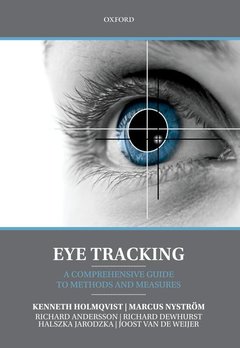Eye Tracking A comprehensive guide to methods and measures
Langue : Anglais
Auteurs : Holmqvist Kenneth, Nyström Marcus, Andersson Richard, Dewhurst Richard, Jarodzka Halszka, van de Weijer Joost

We make 3-5 eye movements per second, and these movements are crucial in helping us deal with the vast amounts of information we encounter in our everyday lives. In recent years, thanks to the development of eye tracking technology, there has been a growing interest in monitoring and measuring these movements, with a view to understanding how we attend to and process the visual information we encounter. Eye tracking as a research tool is now more accessible than ever, and is growing in popularity among researchers from a whole host of different disciplines. Usability analysts, sports scientists, cognitive psychologists, reading researchers, psycholinguists, neurophysiologists, electrical engineers, and others, all have a vested interest in eye tracking for different reasons. The ability to record eye-movements has helped advance our science and led to technological innovations. However, the growth of eye tracking in recent years has also presented a variety of challenges - in particular the issue of how to design an eye-tracking experiment, and how to analyse the data. This book is a much needed comprehensive handbook of eye tracking methodology. It describes how to evaluate and acquire an eye-tracker, how to plan and design an eye tracking study, and how to record and analyse eye-movement data. Practicality lies at the heart of the book, providing in-depth guidance to key questions: how raw data samples are converted into fixations and saccades using event detection algorithms, how the different representations of eye movement data are calculated using AOIs, heat maps and scanpaths, and how all the measures of eye movements relate to these processes. Part I presents the technology and skills needed to perform high-quality research with eye-trackers. Part II examines the predominant methods applied to the data which eye-trackers record. These include the parsing of raw sample data into oculomotor events, and how to calculate other representations of eye movements such as heat maps and transition matrices. Part III gives a comprehensive outline of the measures which can be calculated using the events and representations described in Part II. This is a taxonomy of the measures available to eye-tracking researchers, sorted by type of movement of the eyes and type of analysis. For anyone in the sciences considering conducting research involving eye-tracking, this book is an essential reference work.
1. Introduction. Technical and Methodological Skills. 2. Eye-tracking hardware and its properties. 3. From vague idea to experimental design. 4. Data recording. Detecting Events and Building Representations. 5. Estimating oculomotor events from raw data samples. 6. Areas of interest. 7. Attention maps-scientific tools or fancy visualisations?. 8. Scan paths-theoretical principles and practical application. 9. Auxiliary data III: Events and representations. Measures. 10. Movement measures. 11. Position measures. 12. Numerosity measures. 13. Latency and distance measures. 14. What are eye movement measures and how can they be harnessed?.
Kenneth Holmqvist is an Associate Professor in Cognitive Science at Lund University, where he founded the eye-tracking laboratory in 1995, which later grew into the large Humanities Laboratory. He has worked in a large variety of eye-tracking-based research stretching from reading research and scene perception, over to newspaper reading, advertisement studies and gesture recognition in face-to-face interaction. Kenneth also has expertise in eye tracking used in applied areas, including decision making in supermarkets and research on safety in car driving and air traffic control. In 2000, Kenneth initiated regular master courses in eye-tracking methodology. In 2006, he founded the Scandinavian Conference on Applied Eye-tracking, and in 2008, the international LETA training courses in eye-tracking methodology. Kenneth is the initiator and main author of this book. Marcus Nyström received his PhD in Information Theory from the Department of Electrical and Information Technology at Lund University, Sweden, in 2008, working with foveated video compression and scene perception. He currently works in the Humanities Laboratory at Lund University. His research interests span eye-tracking methodology in general and analysis of eye-tracking data in particular. Richard Andersson is a PhD student in cognitive science and technician at the Lund University Humanities Laboratory. He teaches eye-tracking methodology and provides users with help during the formulation, building and analysis stage of the eye-tracking experiments. Richard Dewhurst is presently a post-doctoral researcher at Lund University Humanities Laboratory, funded by the Swedish Research Council. He completed his PhD on training eye movements at the University of Nottingham in 2009, as part of the Cognition and Language research group. Prior to this he also obtained an MSc in psychological research methods from the University of Nottingham, and a BSc in psychology from the University of Wales, Bangor. His research
Date de parution : 03-2015
Ouvrage de 560 p.
17x24.5 cm
Date de parution : 09-2011
Ouvrage de 560 p.
18x25.3 cm
Thèmes d’Eye Tracking :
© 2024 LAVOISIER S.A.S.



